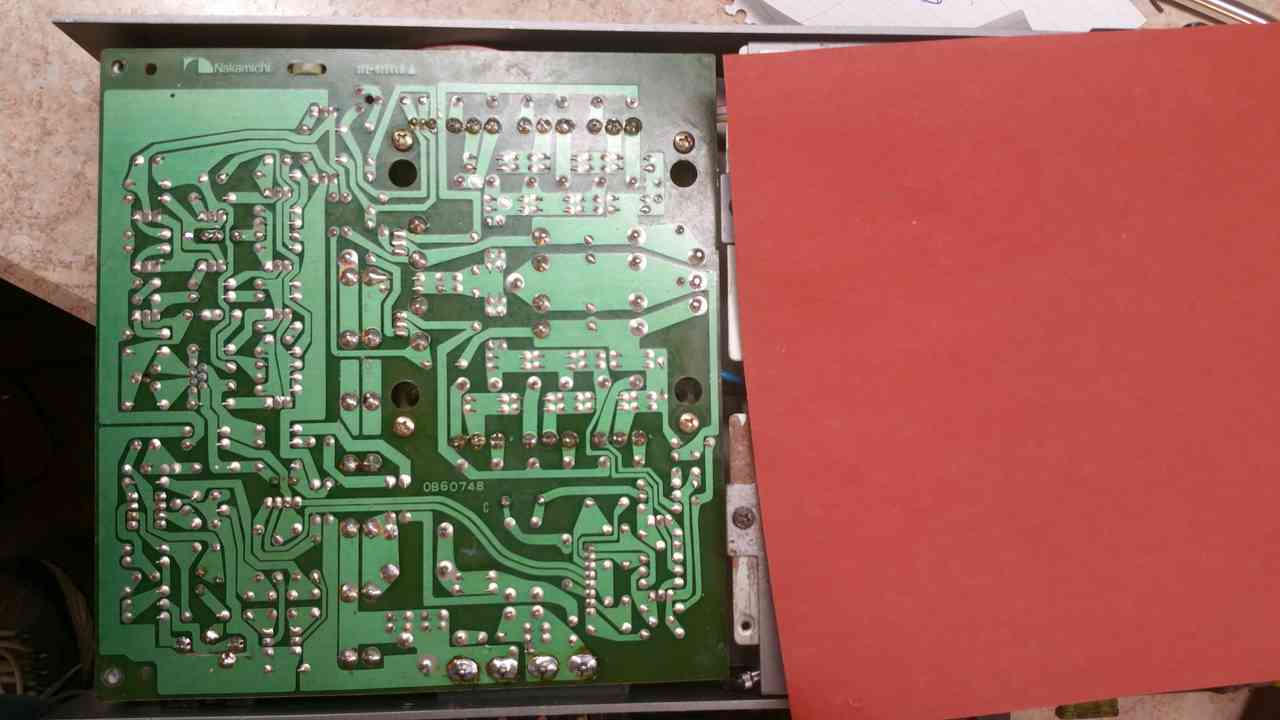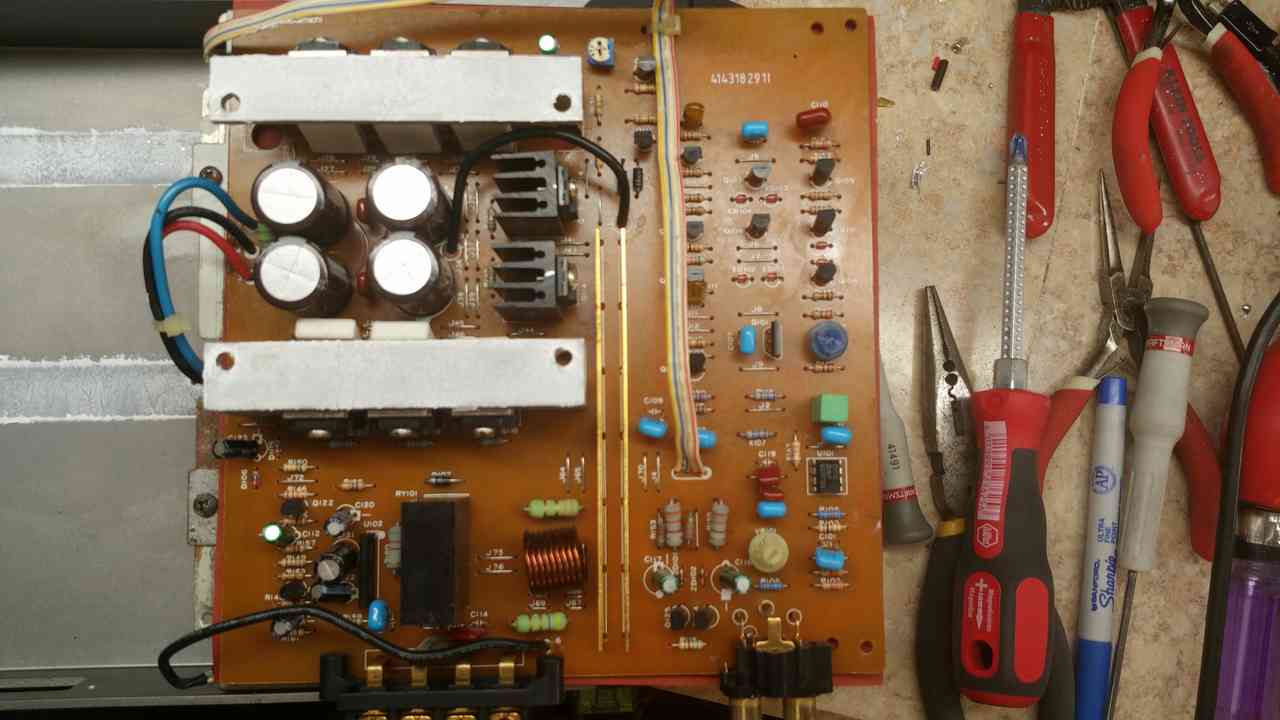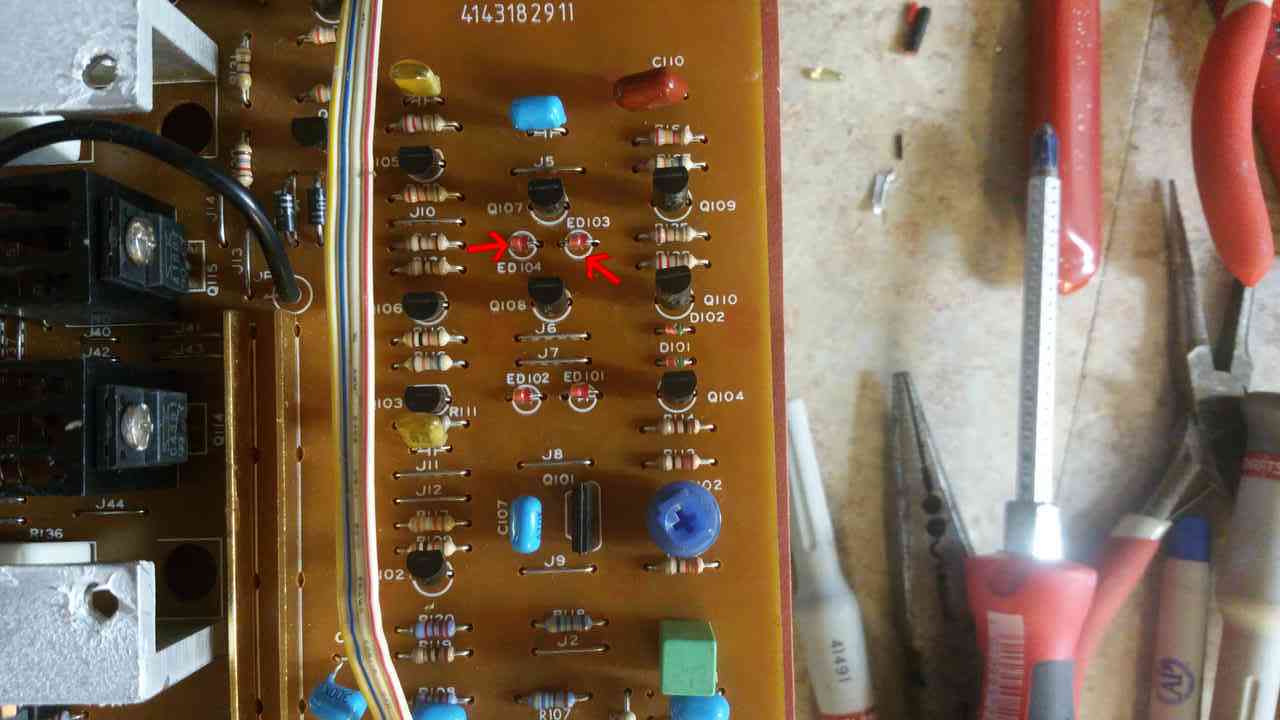Hey guys, I have an older Nakamichi PA-301 I am trying to get up and running and I am running into some snags.
I bought the amp to refurbish, but I have an intermittent problem that I am having trouble tracking down. The amp had some badly leaking input capacitors. I thoroughly cleaned the power supply board, replaced the caps and it fired right up, has rock solid +/- 45V rails. No issue that I can see there. The audio board was covered in flux, but didn't seem to have any electrolyte on it so I scrubbed it down and cleaned it up and powered it on the bench out of sink. It did not draw any abnormal current, but the mute relay did not pull in and the LED's in the picture below labeled ED103/104 did not light. At the same time when I measured the op amp supply it was quite a way off balance. One side was about 19V and the other -16V if I recall correctly. Anyhow, I pulled the two LEDs to test them and they were both fine. I found a few strands of speaker wire under one of them though and cleaned it out and it fired up and worked fine. I reassembled and was playing it on the bench when about 10 minutes in I heard a pop and the speaker relay dropped out. Main supply was still okay, but those two LED's were out again.
I pulled the audio board and went over it looking for more lost strands of wire. I found nothing, I put it back together and it was working again. I let it play at low volume for some time out of sink and it was working fine. I put it back in the sink and played it at quite high output for probably a half hour and it popped and relay disengaged again. I pulled the audio board back out and sat it like you see in the pictures below and it has now continued to run for probably about 45 minutes. I see some old threads when I google search this amp with people saying it randomly quits playing. I don't see a solution in my searches though.
I have looked it over very closely and I don't see any broken leads or board cracks or cold joints. It has done this both when it has been cold and when it has been fairly warm. I don't think it is thermal related, but it may be. Hopefully one of you will have some insight, it is a very nice sounding little amp when it is running...
Pics:



Thanks,
Jason
I bought the amp to refurbish, but I have an intermittent problem that I am having trouble tracking down. The amp had some badly leaking input capacitors. I thoroughly cleaned the power supply board, replaced the caps and it fired right up, has rock solid +/- 45V rails. No issue that I can see there. The audio board was covered in flux, but didn't seem to have any electrolyte on it so I scrubbed it down and cleaned it up and powered it on the bench out of sink. It did not draw any abnormal current, but the mute relay did not pull in and the LED's in the picture below labeled ED103/104 did not light. At the same time when I measured the op amp supply it was quite a way off balance. One side was about 19V and the other -16V if I recall correctly. Anyhow, I pulled the two LEDs to test them and they were both fine. I found a few strands of speaker wire under one of them though and cleaned it out and it fired up and worked fine. I reassembled and was playing it on the bench when about 10 minutes in I heard a pop and the speaker relay dropped out. Main supply was still okay, but those two LED's were out again.
I pulled the audio board and went over it looking for more lost strands of wire. I found nothing, I put it back together and it was working again. I let it play at low volume for some time out of sink and it was working fine. I put it back in the sink and played it at quite high output for probably a half hour and it popped and relay disengaged again. I pulled the audio board back out and sat it like you see in the pictures below and it has now continued to run for probably about 45 minutes. I see some old threads when I google search this amp with people saying it randomly quits playing. I don't see a solution in my searches though.
I have looked it over very closely and I don't see any broken leads or board cracks or cold joints. It has done this both when it has been cold and when it has been fairly warm. I don't think it is thermal related, but it may be. Hopefully one of you will have some insight, it is a very nice sounding little amp when it is running...
Pics:



Thanks,
Jason
Last edited:
I went through a pa300 that I now use, replaced as many of the polyester caps as I could, sounds amazing.
Is there a thermal sensor on it? I wonder what fault it is seeing that causes the shutdown?
I have the bias turned up, and have a fan mounted on it to keep it from melting itself.
I recall mine needed to be installed isolated from the car chassis, as per the owners manual that came with it.
Looking at your pictures, I noticed that there is a Wima film cap in one position, is that one of two that are associated with the servo?
Mine was not tolerant of a different part in that spot for some reason, so the old parts went back in after trying some other parts.
Is there a thermal sensor on it? I wonder what fault it is seeing that causes the shutdown?
I have the bias turned up, and have a fan mounted on it to keep it from melting itself.
I recall mine needed to be installed isolated from the car chassis, as per the owners manual that came with it.
Looking at your pictures, I noticed that there is a Wima film cap in one position, is that one of two that are associated with the servo?
Mine was not tolerant of a different part in that spot for some reason, so the old parts went back in after trying some other parts.
Last edited:
Phase, I have not changed any parts except the two wet caps on the 12v input.
Perry, I looked through the online offering of several of the sources mentioned in your repair tutorial, but no one listed this amp. Do you have any suggestions of where else to check? I have to say, this amp is a bit more difficult to troubleshoot just due to it's design. It seems it is much easier track down issues when you can easily probe both sides of the board...
Yesterday afternoon, that amp ran for more than an hour at medium volume with the audio section out of the sink. After that I would be inclined to think that perhaps an insulator on one of the power transistors was faulty, however, the very first time I powered it up, it was out of the sink and had this same behavior. I have had the fault repeat several times both in and out of the sink.
For what it is worth, as far as I can tell the LEDs I mentioned in the first post are not part of any diagnostics or power indication, they seem to be similar to the LEDs in the audio section of Phoenix Gold MS amps. Also, then the audio section quits working, the power supply is still chugging along perfectly normally.
Thanks for the the input! I will be tinkering with it more today.
Thanks,
Jason
Perry, I looked through the online offering of several of the sources mentioned in your repair tutorial, but no one listed this amp. Do you have any suggestions of where else to check? I have to say, this amp is a bit more difficult to troubleshoot just due to it's design. It seems it is much easier track down issues when you can easily probe both sides of the board...
Yesterday afternoon, that amp ran for more than an hour at medium volume with the audio section out of the sink. After that I would be inclined to think that perhaps an insulator on one of the power transistors was faulty, however, the very first time I powered it up, it was out of the sink and had this same behavior. I have had the fault repeat several times both in and out of the sink.
For what it is worth, as far as I can tell the LEDs I mentioned in the first post are not part of any diagnostics or power indication, they seem to be similar to the LEDs in the audio section of Phoenix Gold MS amps. Also, then the audio section quits working, the power supply is still chugging along perfectly normally.
Thanks for the the input! I will be tinkering with it more today.
Thanks,
Jason
Well, I put a bit more effort into this today. Yesterday I had it apart again and still could not find the issue. I hooked it up to a set of speakers and a power supply yesterday and just let it play for the whole day in the shop. It made it close to 4 hours before it tripped out again. I shut it down and left it for today.
I powered it on the bench today, and it was still in "protect" even though it had cooled all night long. I think this rules out thermal issues. I took the cover and fish paper off the amplifier side and verified that the rails were still there, +/- ~40V, the +/-18 V supply was still up, although a little lopsided. The protection IC had disengaged the relay though, and I probed the output before the relay and I had the full positive rail on the output. This seems to me that the protection IC is doing it's job properly.
Now the really weird. I removed the amplifier from it's side of the sink. The design is kind of odd, the outputs are on a vertical sink that then bolts to the larger sink. The outputs are isolated from their individual small sinks. As soon as I unbolted it, it went out of protect and started working again. So, I got to thinking that maybe an output was leaking through an insulator, and I start probing the vertical heat sinks. There is a few hundred milivolts there, but nothing remotely close to rail voltage. While checking the outputs I happened to probe the top of one of the rail caps (located in the middle of the output heat sinks) while referenced to secondary ground one set of caps had -40V on the case and the other set had about 2V on the case. I thought maybe they caps themselves were shorting to the sink, they are very close, but in normal position they should actually sag away from the sink a bit. I pulled the caps and they are way off spec, so I am going to replace them. I have never, ever, seen an electrolytic with the case hot, but then again, it is not something I would have normally checked.
Anyhow, is it remotely possible that these caps are the root of the issue? I temporarily wired in a pair that I had that are far to big for the mounting location, but plenty of capacitance for test and with the board tight in the sink I couldn't get it to shut down. I didn't have as long to let it play today, so it may still fault after running longer.
Any thoughts? I am having a hard time wrapping my head around why it would play perfect sometimes for hours and then just completely crap out.
Thanks,
Jason
I powered it on the bench today, and it was still in "protect" even though it had cooled all night long. I think this rules out thermal issues. I took the cover and fish paper off the amplifier side and verified that the rails were still there, +/- ~40V, the +/-18 V supply was still up, although a little lopsided. The protection IC had disengaged the relay though, and I probed the output before the relay and I had the full positive rail on the output. This seems to me that the protection IC is doing it's job properly.
Now the really weird. I removed the amplifier from it's side of the sink. The design is kind of odd, the outputs are on a vertical sink that then bolts to the larger sink. The outputs are isolated from their individual small sinks. As soon as I unbolted it, it went out of protect and started working again. So, I got to thinking that maybe an output was leaking through an insulator, and I start probing the vertical heat sinks. There is a few hundred milivolts there, but nothing remotely close to rail voltage. While checking the outputs I happened to probe the top of one of the rail caps (located in the middle of the output heat sinks) while referenced to secondary ground one set of caps had -40V on the case and the other set had about 2V on the case. I thought maybe they caps themselves were shorting to the sink, they are very close, but in normal position they should actually sag away from the sink a bit. I pulled the caps and they are way off spec, so I am going to replace them. I have never, ever, seen an electrolytic with the case hot, but then again, it is not something I would have normally checked.
Anyhow, is it remotely possible that these caps are the root of the issue? I temporarily wired in a pair that I had that are far to big for the mounting location, but plenty of capacitance for test and with the board tight in the sink I couldn't get it to shut down. I didn't have as long to let it play today, so it may still fault after running longer.
Any thoughts? I am having a hard time wrapping my head around why it would play perfect sometimes for hours and then just completely crap out.
Thanks,
Jason
Just a quick update. I have now ran this for more than 24 hours with no fault, first with my temporary caps in there and then with permanent replacements installed. After I got it good and warm I brought it over to the bench to check bias and as I started to adjust bias pot, I hear the protection relay trip. Seems the pot is in pretty rough shape, I pulled it from the board and cleaned it up and got it working smoothly and put it back in and was able to adjust the bias to the spec in the manual with no issues. This amp also has a DC offset adjustment pot. This isn't mentioned in the service manual for the PA-302 and I am guessing it doesn't actually exist in that amp, but I was able to trim the ~20mv of offset down to virtually nothing. I let it run for several hours again and rechecked and everything was still good so I decided to button it back up.
I ran it for several more hours and it still preformed flawlessly so I think I am going to tentatively mark this one off as done. I suspect that the dirty pots may have been the ultimate cause of issue. Does anyone see a flaw in my thinking? I would like to sell this amp, but I don't really want to send it out if I haven't found the root cause of the issue.
Thanks,
Jason
I ran it for several more hours and it still preformed flawlessly so I think I am going to tentatively mark this one off as done. I suspect that the dirty pots may have been the ultimate cause of issue. Does anyone see a flaw in my thinking? I would like to sell this amp, but I don't really want to send it out if I haven't found the root cause of the issue.
Thanks,
Jason
- Status
- This old topic is closed. If you want to reopen this topic, contact a moderator using the "Report Post" button.
- Home
- General Interest
- Car Audio
- Anyone familiar with older Nakamichi amps(PA-301)?